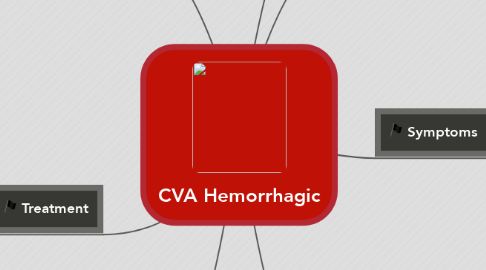CVA Hemorrhagic
por Justin Siegfred Hermogeno

1. Types
1.1. Intracerebral Hemorrhage
1.1.1. a blood vessel in the brain bursts and spills into the surrounding brain tissue, damaging brain cells.
1.2. Subarachnoid Hemorrhage
1.2.1. an artery on or near the surface of your brain bursts and spills into the space between the surface of your brain and your skull.
2. Definition
2.1. Hemorrhagic stroke occurs when a blood vessel in your brain leaks or ruptures.
3. Symptoms
3.1. Trouble with walking. You may stumble or experience sudden dizziness, loss of balance or loss of coordination.
3.2. Trouble with speaking and understanding. You may experience confusion. You may slur your words or have difficulty understanding speech.
3.3. Paralysis or numbness of the face, arm or leg. You may develop sudden numbness, weakness or paralysis in your face, arm or leg, especially on one side of your body.
3.4. Trouble with seeing in one or both eyes. You may suddenly have blurred or blackened vision in one or both eyes, or you may see double.
3.5. Headache. A sudden, severe headache, which may be accompanied by vomiting, dizziness or altered consciousness, may indicate you're having a stroke.
4. Diagnostics
4.1. Physical examination.
4.2. Blood tests.
4.3. Computerized tomography (CT) scan.
4.4. Magnetic resonance imaging (MRI).
4.5. Cerebral angiogram.
5. Risk Factors
5.1. High blood pressure
5.2. Cigarette smoking
5.3. High cholesterol
5.4. Diabetes.
5.5. Being overweight or obese.
5.6. Cardiovascular disease
5.7. Heavy or binge drinking
6. Treatment
6.1. Emergency measures. If you take warfarin (Coumadin) or anti-platelet drugs such as clopidogrel (Plavix) to prevent blood clots, you may be given drugs or transfusions of blood products to counteract their effects.
6.2. You may also be given drugs to lower pressure in your brain (intracranial pressure), lower your blood pressure or prevent seizures.
6.3. People having a hemorrhagic stroke can't be given clot-busters such as aspirin and TPA, because these drugs may worsen bleeding.
6.4. Once the bleeding in your brain stops, treatment usually involves bed rest and supportive medical care while your body absorbs the blood.
7. Surgery
7.1. Surgical clipping. A surgeon places a tiny clamp at the base of the aneurysm, to stop blood flow to it.
7.2. Coiling (endovascular embolization). A catheter is inserted into an artery in your groin and guides it to your brain using X-ray imaging. Then tiny detachable coils are guided into the aneurysm (aneurysm coiling). The coils fill the aneurysm, which blocks blood flow into the aneurysm and causes the blood to clot.



